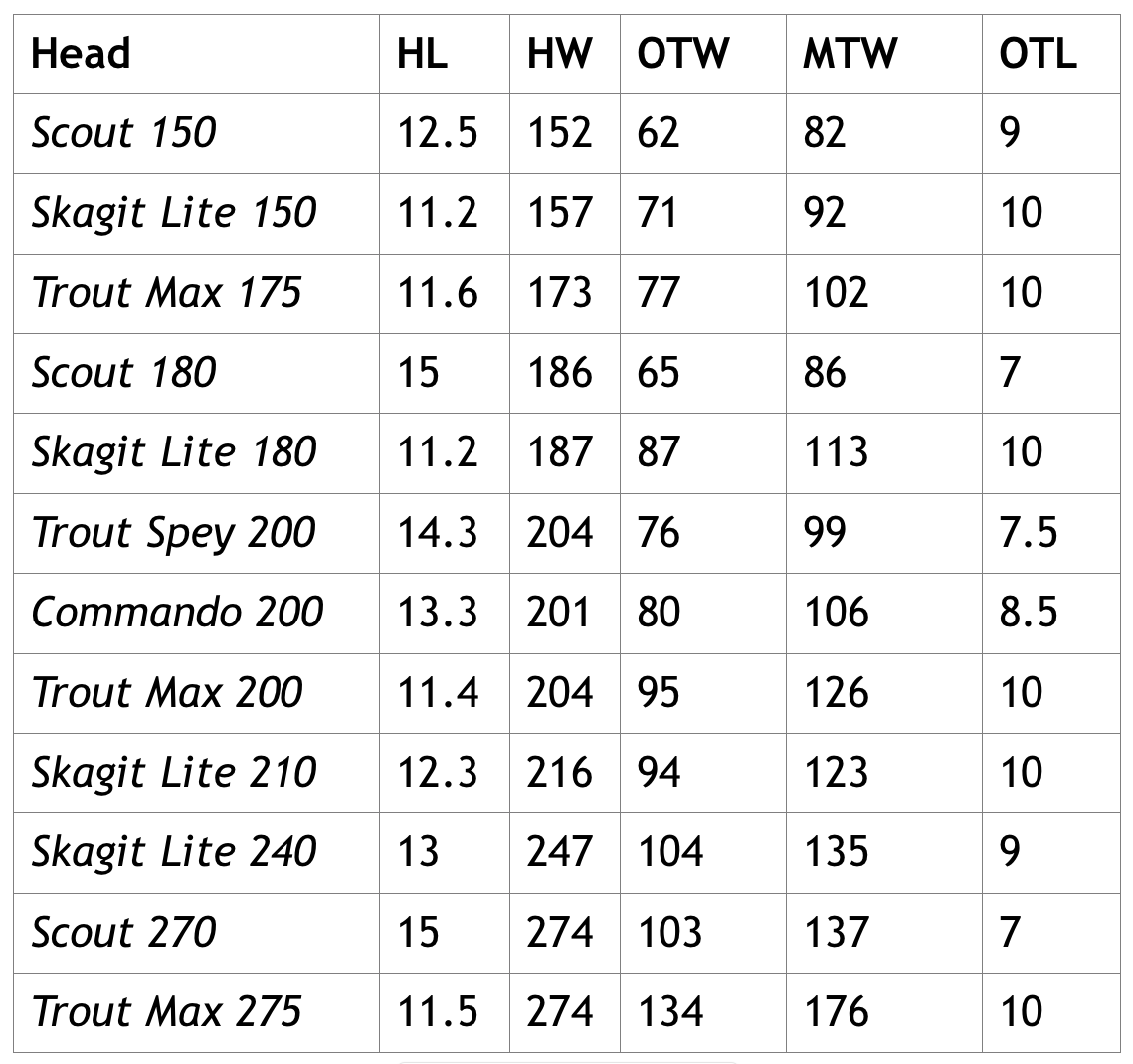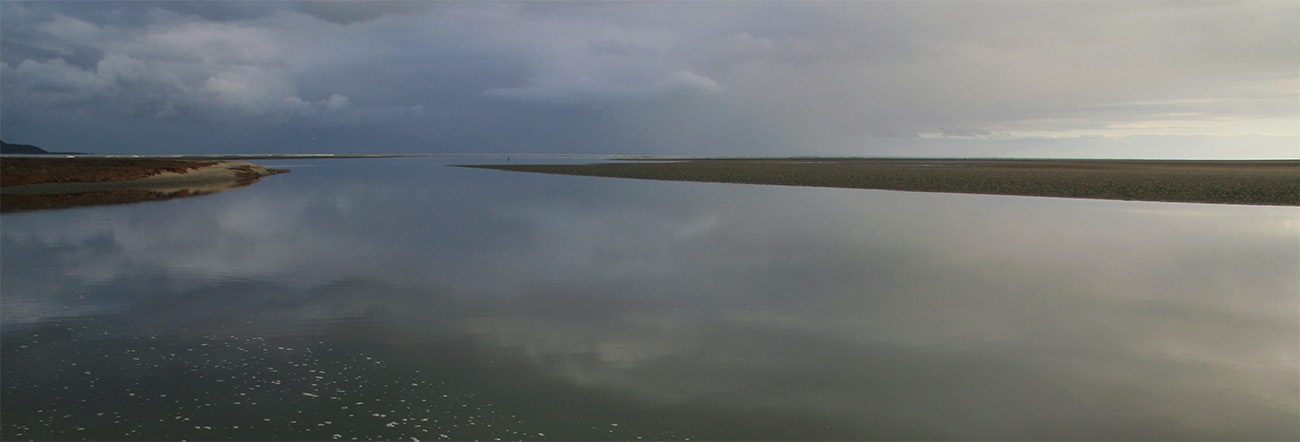The performance of a floating Skagit head of a given grain weight is determined mainly by its total head length, and then by its head profile. I discuss details of these two design components to help others when selecting single-hand micro-Skagit heads for different fishing situations.
Head Length:
1. I was initially drawn to micro-Skagit heads because I thought they would enable me to fish heavy streamers and sink tips on my regular trout rods, and also learn to Spey cast.
My first revelation on this journey of surprises was that a micro-Skagit head of just a few feet shorter is able to cast substantially heavier sink tips and flies, than a longer head of the same total weight. The ability to cast weight is directly proportional to the number of grains per foot. I also found that just 25-30 grains in head weight makes a huge difference to head performance on a 5 wt single handed rod, in terms of both rod loading and the length and weight of the sink tip it can cast.
2. Based on the results of my extensive tip/head combination trials, I came up with the following formula for predicting the optimum sink tip grain weight (OTW) for floating micro-Skagit heads of 11-15 ft long, when cast on single hand rods:
OTW = HW/HL x Ln(HW),
where HW is head weight in grains, HL is head length in decimal feet, and Ln is the natural logarithm. Maximum sink tip weight, better tackled by experienced casters, is obtained by increasing the OTW value by 30%.
3. Apart from lifting more weight, a shorter Skagit head is also able to cast longer sink tips on a rod of equivalent length. This is because the optimum tip length is determined by the ratio of head + tip length to rod length. Ideal head + tip to rod length ratios are 2.2-2.5 for heavy sink tips and 2.5-2.8 for light sink tips. Heavy tips are roughly 30-50% the weight of the head, but are more accurately given by the formula for OTW, which takes head length into account.
4. Although the optimum head+sink tip to rod length ratio is about 2.4 for heavy sink tips, I found that when lengths of level-T, predicted by this ratio, were longer than the rod, they were difficult to cast. Compound tips with intermediate sinking butt sections (e.g. Flo and iMOW), that were the length of the rod or even longer, were, by contrast, easy to cast, as long as the level-T section was shorter than the rod. By way of example, 10 ft of level T-8 was much harder to cast on an 11.5 foot Trout Max 200 head and 9 ft rod than were 10.5 ft T-7 and T-10 Flo tips, even though the Flo tips were much heavier than 10 ft of T-8, see 'Table of Lengths and Weights of Sink Tips'.
Nine feet of straight T-8 or even T-11, on the other hand, was no problem at all on the 9 ft rod with the Trout Max 200. The floating and intermediate butt portions of compound tips essentially extend the Skagit head, effectively translating to casting a longer head and shorter tip. The take home message being: level-T material should not exceed the length of the rod.
5. Based on the ratios presented in (3) above, longer rods are able to cast longer sink tips on a Skagit head of given length (provided the longer tip does not exceed the predicted weight range). Every 0.5 ft in rod length adds around 1.2 ft to the optimal sink tip length. However, as longer tips become easier to cast on longer rods, so shorter tips become more difficult, because of reduced ‘line stick’.
6. Optimum (OTW) and Maximum (MTW) heavy sink tip weights (in grains) for single hand use of the Skagit heads used in my experiments, based on the formula in bullet 1, are provided in the table below. Also given is the sink tip length (OTL = Optimal Tip Length) required to produce a Head + Tip to rod length ratio of 2.4 for a 9 ft rod. HL and HW are the actual (measured) length and weight of each head, in decimal feet and grains, respectively.

7. As a function of the physics behind the formulas in 1 and 2, and the caveat in bullet 4, the ideal Skagit head length for casting heavy sink tips of 9 to 10 ft on a 9 ft single hand rod is 11.2 - 12.3 ft, i.e 1.2 to 1.33 times the rod length.
8. Given that the optimal head + tip to rod length ratio is around 2.6 for light sink tips, the ideal head length for 10 ft light tips on a 9 ft rod is 15 ft. Because they have fewer grains per foot, longer heads generally make less splash, and therefore excel at delicate presentations with light sink tips (delicate being a relative term). Longer head systems also tend to cast further, because they take longer to turn over, and they require less stripping when swinging flies. But then, of course, they can’t be stripped as close.
Head Profile:
1. Aside from length and grains per foot, the profile also influences performance of a Skagit head. The impact of the front taper design is perhaps most marked on micro-Skagit heads because they are so short, and is best demonstrated by directly comparing the profiles of Skagit heads I tested. Key differences in the profiles of Skagit heads I tested revolved around the length and nature of the front taper, including the diameter of the Skagit head tip.
2. The OPST Commando, the original micro-Skagit, had a ‘beer can’ design, with no front taper at all in the 200 grain version. This design resulted in recoil on turnover with heavy tips, and 9 ft lengths of level-T not always landing straight. Presentation was substantially improved with a T-7 Flo tip, as it included a strong taper down to the section of level-T, which smoothed turnover.
3. When Rio produced the 11 ft Trout Max they introduced a strong 2.5 ft front taper that placed more weight in the central portion of the D-loop and went some way toward smoothing the turn-over of 9 ft level-T tips. The strong front taper on the Trout Max, ending in skinny tip for a Skagit head, also resulted in less hinging between head and sink tip whilst on the water - because the tip is pulled progressively under water by the weight of the sink tip.
The short strong taper, nevertheless, resulted in rapid turn-over, and in conjunction with short head length (11 ft), limited casting distance. Casting distance was noticeably improved with a 10 ft Flo tip, which effectively increased the length of both head and front taper, via the 2.5 ft of tapered intermediate material.
4. The Scout 180 had a 5.5 ft gradual front taper, which resulted in slower less aggressive turnover than the Trout Max and, in conjunction with greater head length and thinner belly, better distance and presentation with lighter sink tips. Although fewer grains per foot meant the Scout could cast less weight, the relatively thick tip nevertheless enabled it to easily turn over 7.5 ft of T-8 and a weighted streamer. Because the tip was thicker than that of the Trout Max, hinging on the water with 7.5 ft of T-10 was more noticeable.
5. While a longer front taper delays turnover and smooths energy transfer, if the tip is too skinny, and the taper too thin, the head will not have the grunt to turn over the weight predicted by the formulas in the preceding section. The 4.5 ft front taper on Rio’s 200 grain Skagit Trout Spey was, by way of example, too skinny to adequately deal with level-T sink tips.
6. The Scientific Angler Skagit Lite series had the longest and most sophisticated front taper of any of the heads I tested. Comprising 66-80% of the head length, the front taper was gradual for the most part, becoming slightly more acute over the last foot or so, but ending in a relatively thick tip. The net result was amazing distance and presentation, for the respective head lengths, with 9 ft Level-T and 10 ft compound sink tips. Another advantage of the near delta profile, which packs more weight into the upper portion of the D-loop where it is most efficient at loading the rod, was exceptional roll and touch and go casting with heavy sink tips.
7. Head designs with rear weighting, such as the Skagit Lite series and the Skagit Scout, required fewer total grains to load a given rod, e.g. 180 grains instead of 200 grains for a standard 5 wt single hand rod. This was the result of two factors: 1) a thicker rear section generating greater water resistance and hence rod load during the sweep part of a water loaded cast - e.g. double Spey or Perry Poke - and 2) greater weight in the upper portion of the D-loop increasing rod load during the roll cast.
Single Hand Skagit - Science behind the magic |
|
| + | Where it all began |
| + | Head design |
| + | Sink tips |
| + | Casting heavy sink tips |
| + | Running lines |
| + | Reels |
| + | Rods |
| + | Intermediate heads |
| + | Favourite outfits |
| + | Conclusions |
| + | Shootout of 12 Skagit Heads I tested |
| + | Table of Sink Tip Recommendations |
| + | Table of Lengths and Weights of Sink Tips |
Single hand Trout Spey : Getting started with a 9 ft 5wt rod |
|
| + | Getting started |
| + | Rods and Skagit heads |
| + | Sink tips for Skagit heads |
| + | Tippet for Skagit heads |
| + | |
| + | Hybrid heads |
| + | Floating tips for Skagit heads |
| + | Running lines |
| + | Cost effective approach |
| + | Learning to Spey cast |
| + | A final word |
